How To Open Tomcat Configuration Window
This guide is divided into 2 parts. The outset office outlines the installation of Apache Tomcat on a Windows system. The second function explains how to install the Terminalfour software once you Apache Tomcat server has been configured.
Installing Apache Tomcat 9
If you haven't already washed so, download the 32-bit/64-chip Windows Service Installer for Apache Tomcat 9, this is available from the download page. At that place are other installers available, only this particular installer will create the Windows service for Apache Tomcat for you.
- Run the installer and follow the screens until the Choose Components screen:
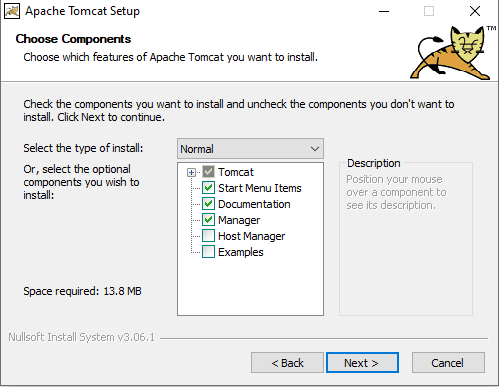
- The but necessary component is the "Tomcat" component; nevertheless, it may prove useful to install the standard options (selected past default). If your machine is open up to the net on port 8080, information technology is best to only install the Tomcat component. Continue to the next screen later selecting your components.
- This screen allows y'all to ascertain the port on with Tomcat will listen also as a username and countersign for the Tomcat Director component application (if you chose to install this). Information technology is preferred to leave Tomcat listening on port 8080 for HTTP:

- Yous will now be asked to select your Java Virtual Machine or JVM. Your arrangement'due south default JVM should be picked up automatically; however, yous can change this to another JVM instance if you wish.
Merely Oracle Java eleven is supported past Terminalfour 8.3+Once selected, follow the screens until Tomcat has been installed:
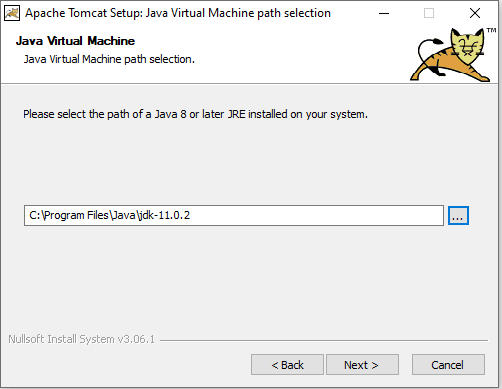
- The next screen will ask you lot where you lot would like to install Tomcat. Any file system location is fine. In one case y'all have chosen your directory, go to the adjacent screen:
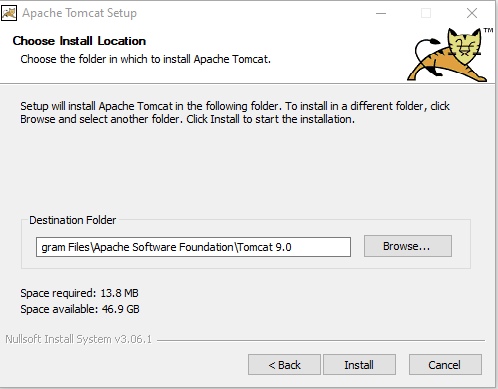
Post Installation Configuration of Tomcat 9
Setting the Tomcat process to showtime automatically
If you chose the installer package outlined above, a Windows service would have been created during the installation procedure. This process should exist set to run automatically when the system starts:
- To open the Windows Services command panel, Go to Kickoff and search for "View Local Services".
- Locate the procedure for Tomcat 9 in the listing, then right-click and select properties . A new window opens:

- On the General tab, modify the process's Startup type to Automated. You should also offset the process if you lot have non already done then:
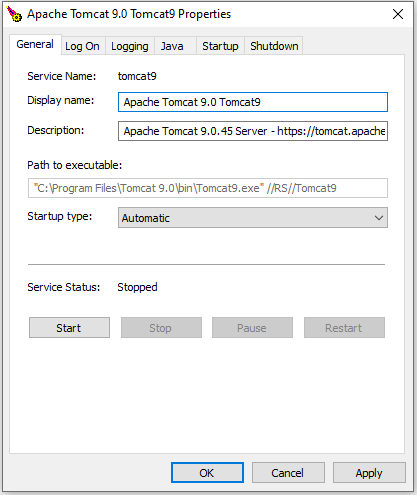
- On the Log On tab, you lot tin can change the user Tomcat runs every bit. This is just necessary if you program to publish your website to a file share. To modify the user, select This Business relationship then enter an advisable username and password for that shared location.
Changing the Java memory parameters for Tomcat
When Tomcat is installed, it volition only run with a default retention allotment. It is recommended that this retentivity allotment is altered to at least ii gigabytes and if possible four gigabytes:
- Open up the Configure Tomcat application. If Tomcat is running, you lot should have an item in the organization tray for Tomcat which yous can right-click on and select Configure . Otherwise, open up the folder you have installed Tomcat in, and then run the program "tomcat9w.exe" which will be in the bin folder.
- On the Java tab, you lot can specify the memory allocations for Java. Accept a expect at the recommended memory allocation settings in this article.
- Java Surroundings Variables can too exist gear up from this menu nether Java Options . Our recommended Environs Variables are:
-Djava.util.Arrays.useLegacyMergeSort=true
-Djava.awt.headless=true
-XX:-OmitStackTraceInFastThrow
These should be added below the default options:
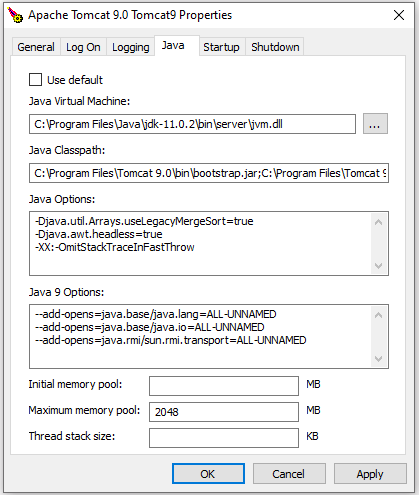
- Select Utilise to save your changes.
- Switch dorsum to the General tab and so End and Get-go Tomcat to ensure your retentivity settings are okay.
Verify your Tomcat installation
To rapidly check that Tomcat has installed without mistake and is running, navigate to http://localhost:8080/ where you lot should see the default dwelling house folio for Tomcat:
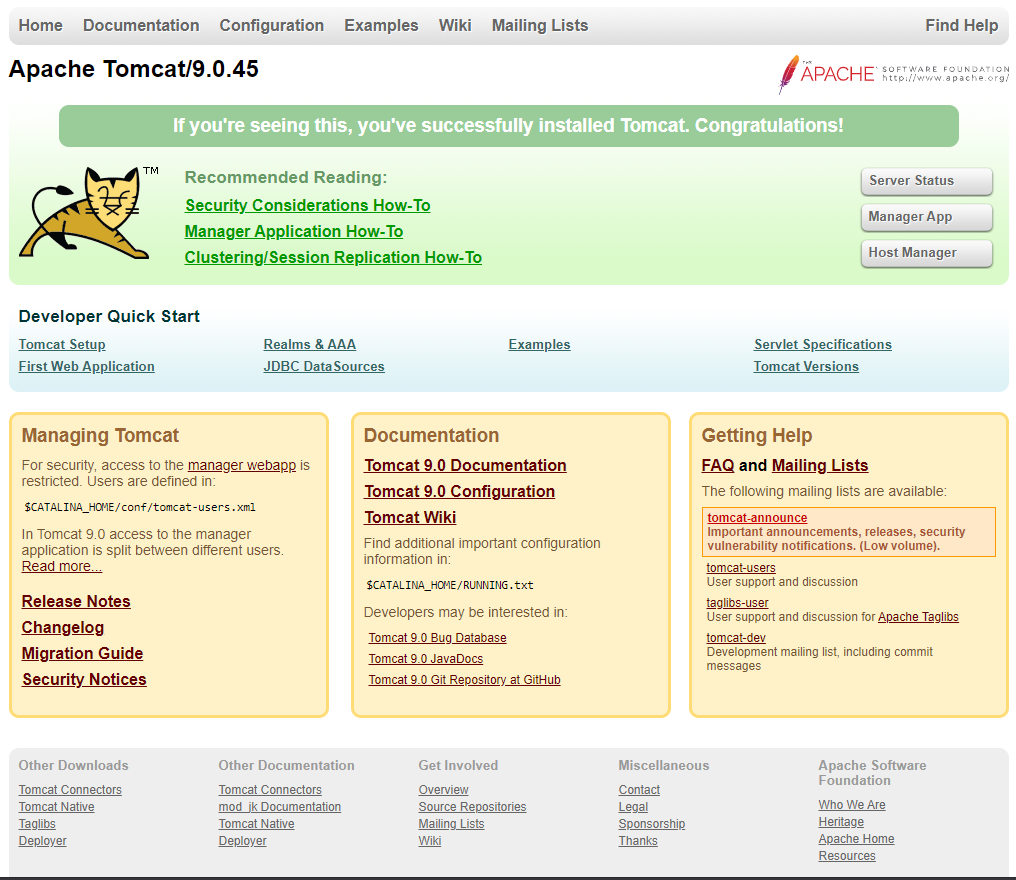
Setting Up Terminalfour in Apache Tomcat 9
To fix Terminalfour you need to do the following:
- Create a binder structure for Terminalfour
- Add the JDBC commuter for your database into Tomcat
- Configure Tomcat's server.xml file for Terminalfour
Create a folder structure for Terminalfour
It is recommended the following folders are created every bit outlined in the image beneath.
The main Terminalfour folder tin be placed anywhere on your file system, this guide assumes information technology is located on the C drive as C:\Terminalfour\
filestoreStores all media files that are added to Terminalfour
| Item | Description |
|---|---|
| servlets | Stores the main Terminalfour WAR file |
| temp | Can be set as the temporary file directory for Terminalfour |
| changesets | Should be used to hold the changeset directories for Transfer Managing director |
| preview | Directory used for setting up a preview filter |
| publish-transfer-logs | Can be used to store achived publish/transfer logs |
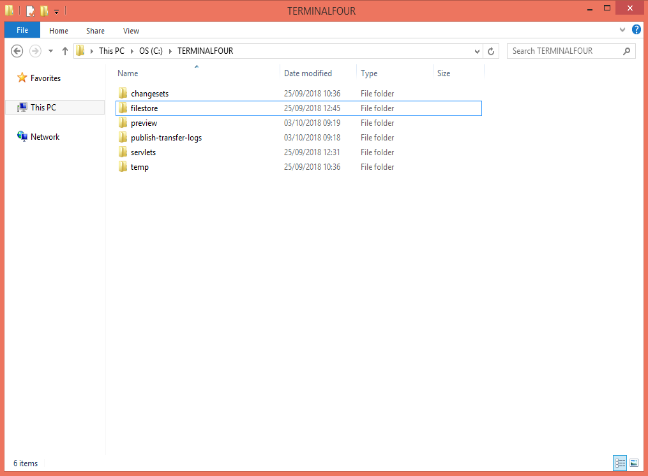
Afterwards creating the folder structure, place your Terminalfour WAR file into the servlet's directory.
Add the JDBC driver for your database into Tomcat
The JDBC driver for your database should exist placed into the lib binder of your Tomcat installation. This is a JAR file that will exist specific to your database blazon and version. For Oracle systems nosotros recommend the use of the Oracle Thin JDBC Commuter; however, the OCI driver will work.
You lot can see the list of supported databases here.
Configure Tomcat's server.xml file for Terminalfour
We need to tell Tomcat where to find the Terminalfour files and how to run them. This is washed by editing the server.xml file located in the conf folder for your Tomcat installation. Open up this file for editing and add in the following code towards the bottom of the file simply before the </host> tag. There are three resources available below; please use the resource which is appropriate for your arrangement and remember to edit any information in bold to match your particular setup.
The path indicated in bold needs to be changed to match the path to your WAR file.
For Terminalfour Version viii.3+, we advise that there are 200 connections available to the database.
MySQL:
<Context path="/terminalfour"
docBase="/usr/share/tomcat9/webapps/servlets/terminalfour-8.3.9-Terminal.state of war"
reloadable="fake"
antiJARLocking="true">
<Resource driverClassName="com.mysql.jdbc.Driver"
maxActive="200"
maxIdle="xx"
name="jdbc/SiteManagerDB"
username="DATABASE_USER"
countersign="DATABASE_PASSWORD"
type="javax.sql.DataSource"
url="jdbc:mysql://DATABASE_HOST/DATABASE_NAME?zeroDateTimeBehavior=convertToNull&characterEncoding=UTF-8&useSSL=false"
validationQuery="SELECT 1"
maxWait="-ane"
removeAbandoned="truthful"
removeAbandonedTimeout="600"
minEvictableIdleTimeMillis="600000"
factory="org.apache.tomcat.jdbc.pool.DataSourceFactory"
jdbcInterceptors="ResetAbandonedTimer"
logAbandoned="truthful"
testOnBorrow="truthful"
testOnReturn="truthful"
testWhileIdle="true"
timeBetweenEvictionRunsMillis="1200000" />
</Context>
Microsoft SQL Server:
<Context path="/terminalfour"
docBase="/usr/share/tomcat9/webapps/servlets/terminalfour-8.iii.ix-FINAL.war"
reloadable="false"
antiJARLocking="truthful">
<Resources driverClassName="com.microsoft.sqlserver.jdbc.SQLServerDriver"
maxActive="200"
maxIdle="xx"
proper noun="jdbc/SiteManagerDB"
username="DATABASE_USER"
password="DATABASE_PASSWORD"
type="javax.sql.DataSource"
url="jdbc:sqlserver://DATABASE_HOST;DatabaseName=DATABSE_NAME"
validationQuery="SELECT 1"
maxWait="-i"
removeAbandoned="true"
removeAbandonedTimeout="600"
minEvictableIdleTimeMillis="600000"
manufacturing plant="org.apache.tomcat.jdbc.pool.DataSourceFactory"
jdbcInterceptors="ResetAbandonedTimer"
logAbandoned="true"
testOnBorrow="true"
testOnReturn="truthful"
testWhileIdle="true"
timeBetweenEvictionRunsMillis="1200000" />
</Context>
Oracle (assuming Oracle Sparse JDBC client):
<Context path="/terminalfour"
docBase="/usr/share/tomcat9/webapps/servlets/terminalfour-8.3.9-FINAL.war"
reloadable="false"
antiJARLocking="truthful">
<Resource driverClassName="oracle.jdbc.driver.OracleDriver"
maxActive="200"
maxIdle="20"
name="jdbc/SiteManagerDB"
username="DATABASE_USER"
password="DATABASE_PASSWORD"
type="javax.sql.DataSource"
url="jdbc:oracle:thin:@(DESCRIPTION=(ADDRESS=(PROTOCOL=TCP)(HOST=DATABSE_HOST)(PORT=1521))(CONNECT_DATA=(SERVER=Dedicated)(SERVICE_NAME=SCHEMA)))"
validationQuery="SELECT 1"
maxWait="-1"
removeAbandoned="true"
removeAbandonedTimeout="600"
minEvictableIdleTimeMillis="600000"
factory="org.apache.tomcat.jdbc.pool.DataSourceFactory"
jdbcInterceptors="ResetAbandonedTimer"
logAbandoned="truthful"
testOnBorrow="true"
testOnReturn="true"
testWhileIdle="true"
timeBetweenEvictionRunsMillis="1200000" />
</Context>
Relieve your server.xml file and restart Tomcat using the Windows Services control panel. Y'all should now be able to access Terminalfour by navigating to http://localhost:8080/terminalfour/SiteManager in your web browser. This will present you with the screen.
Go to Step 3 – Terminalfour Installation
Dorsum to topSource: https://docs.terminalfour.com/articles/install-terminalfour/application-server-installation/windows-and-apache-tomcat/
Posted by: maxwellancons38.blogspot.com

0 Response to "How To Open Tomcat Configuration Window"
Post a Comment